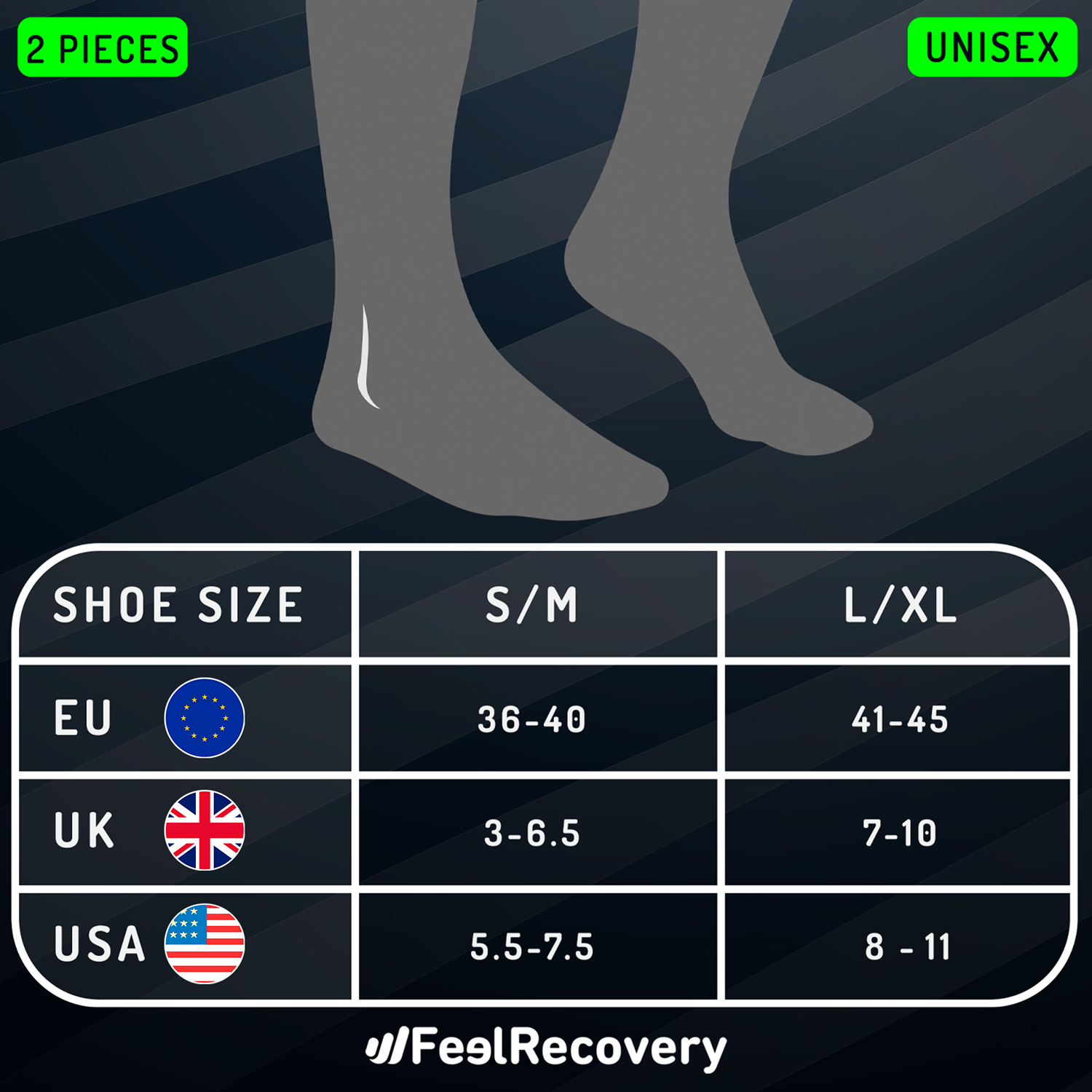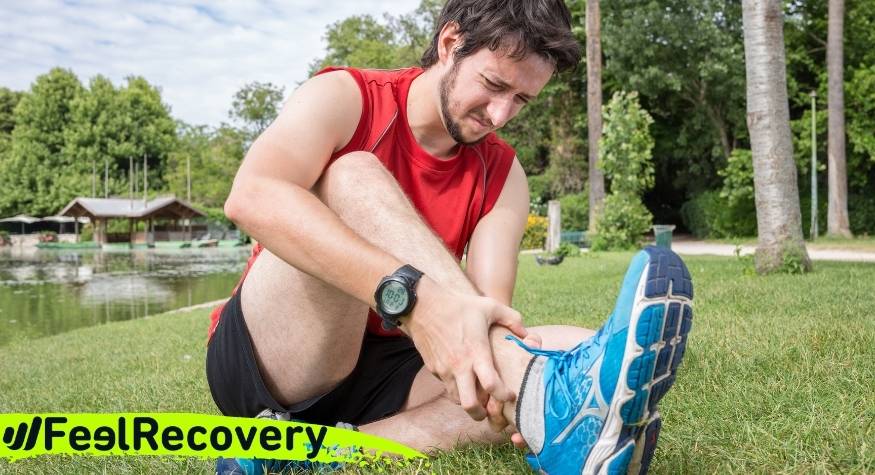The ankle is a complex joint because it contains the ends of the tibia, fibula and calcaneus of the foot. Its function is to provide stability to the person when walking and to balance the load to avoid unnecessary displacement of ligaments and other soft tissues.
In this article, learn about the most common types of ankle injuries, the causes of the main ailments and the signs to look out for to quickly deal with a possible injury.
What types of ankle injuries can we suffer?
Both soft tissue and bony structures are prone to damage depending on the type of injury affecting the individual. The worst injuries tend to occur from trauma due to road traffic accidents, falls and from overdoing sports or work activities.
Bursitis
In every joint there are bursae, these small sacs are responsible for protecting the bones from rubbing during joint movement. These bursae can become inflamed and fill with synovial fluid that must be drained out of the body.
Physical activities such as repetitive jumping or jumping from a high altitude cause the bursa to become damaged and there is a sudden sharp pain inside the joint. Advancing age and physical inactivity are often the triggers for this condition.
Tendonitis
The best known injury is Achilles tendonitis. The Achilles tendon runs from the lower calf to the heel of the foot and must therefore pass through the ankle joint, greatly influencing the mobility of this joint.
The Achilles tendon is very resilient, however, if the body is not well nourished or is not ready to withstand high stresses, then the result will be the rupture of small fibres in the ankle area. In cases where the tendon ruptures completely, surgery is required.
Sprains
Resting the foot in plantar flexion on uneven ground is the main cause of an ankle sprain. The entire load falls on the external ligaments, and even a slight irregular displacement causes a 50% imbalance that ends in an abrupt stretching of the tendons.
When this sudden stretching occurs, the ligaments suffer partial or total tears. A sprain has three degrees, in the worst cases the soft tissue is completely ruptured and requires surgery. Some people are more prone to an ankle sprain at the slightest twist of the foot.
Fractures
These are considered to be the injuries that cause the most damage to the joint. The calcaneus, tibia and fibula can break at their ends due to a heavy fall, trauma or as a result of intense sporting activity.
When the fracture breaks through the skin and damages the soft tissues surrounding the ankle, reconstructive surgery must be performed to repair the affected ligaments and tissues. There may also be one or more cracks that are often not felt if they occur in other parts of the body, but are felt in the an kle because it is constantly in motion.
Dislocations
Also known as dislocation, this is the partial or total displacement of the tibia or fibula at the ends that are connected by the talus. It is an injury that is common in traffic accidents and causes severe pain.
However, a bad stride while walking or running also causes dislocations. Women who often wear high heels are also prone to this injury. Only by mechanically repositioning the bone in place, can there be a decrease in pain and inflammation.
Achilles tendon rupture
This is an injury that people over the age of 50 are more prone to as a result of loss of elasticity of the soft tissues, or degenerative diseases such as arthritis. When it occurs, the connection between the calf and heel is lost, making movement of the ankle completely impossible.
The primary symptom is a loud popping sound at the base of the calf, followed by swelling and intense pain. Surgery is usually performed in these cases, especially when the rupture is complete. Rehabilitation requires several months of physiotherapy treatment.
Torn deltoid ligament
This is the ligament that connects the talus and calcaneus to the tibia, and is extremely important in providing stability to the movement of the foot from top to bottom and vice versa. It can be injured by a movement that forces the sole of the foot to lift unnaturally towards the outside of the ankle, this usually occurs in the case of a fibula fracture.
This is a serious injury, requiring surgery if there is a very pronounced or even total tear. Severe pain is felt and swelling of the ankle will not be long in coming, requiring immediate immobilisation so that the damage does not worsen.
Best products for recovering from ankle injuries
Bestseller
-
2 Ankle Compression Sleeve (Black/Gray)
£17,50 -
2 Ankle Compression Sleeve (Green/Navy)
£17,50 -
2 Ankle Compression Sleeve (Pink/Bordeaux)
£17,50 -
Ice Pack for Foot - Cold Therapy Socks (Black)
£21,95 -
Ice Pack for Foot - Cold Therapy Socks (Green)
£21,95 -
Ice Pack for Foot - Cold Therapy Socks (Pink)
£21,95 -
Microwavable Heated Slippers (Hearts)
£21,50 -
Microwavable Heated Slippers (Oxford)
£21,50 -
Microwavable Heated Slippers (Sport)
£21,50 -
Microwaveable Wheat Bag for Pain Relief (Hearts)
£17,50 -
Microwaveable Wheat Bag for Pain Relief (Oxford)
£17,50 -
Microwaveable Wheat Bag for Pain Relief (Sport)
£17,50 -
Sport Compression Socks (1 Pair) (Black/Gray)
£17,50 -
Sport Compression Socks (1 Pair) (Green/Navy)
£17,50 -
Sport Compression Socks (1 Pair) (Pink/Bordeaux)
£17,50
What are the causes of ankle pain?
There are several risk factors to be aware of, either in your daily life (at home or at work) or when doing sport. These are factors that will increase the likelihood of injury, in this particular case to the ankle.
Muscular dystrophy
Not all ankle complaints are directly caused by ankle injuries. Sometimes, the origin is an associated discomfort, as in the case of muscular dystrophies. This is an alteration in the size and function of the muscles that puts more strain on the soft tissues of the joint.
An example of this would be calf tears which, when not treated correctly, cause the tendons and ligaments to have a greater workload and give way more easily with damage to the attachment of the bones that make up the ankle.
Overwork
Stress at home or at work will cause "knots" to exist in the muscle fibres of the leg and again their malfunctioning impairs the mobility of the ankle. Standing all day or driving for long hours puts a strain on the muscles.
The ankle joint is sensitive to these kinds of changes in people's habits, so try to take some time off each day to rest your legs and avoid a poor distribution of body weight on the lower limbs.
Sedentary lifestyle
Everyone needs to spend at least 45 minutes a day exercising the muscles and joints of the body. The age of computers and smartphones is causing people to spend more time inactive, sitting for much of the day working in front of a computer without any physical activity.
Sedentary lifestyles affect joint performance by weakening ligaments and tendons. In addition to all the associated diseases, such as muscular dystrophy, coronary problems, depression, etc. It is important to set aside part of the day to exercise every part of the body.
Stress overload
This is the opposite of a sedentary lifestyle. Intense sporting or work activities without rest will cause all the components of the ankle to wear out and make it more prone to injuries of all kinds.
The worst thing that can happen is the weakening of cartilage which will result in a lower quality of life for people, as cartilage does not have the ability to regenerate like muscles and ligaments. Sports such as football where the player makes continuous changes of pace, turns and jumps, take this joint to the extreme.
What are the symptoms of ankle pain?
One thing is the clinical diagnosis in which the origin and treatment of an injury is confirmed, another are the signals your body gives to let you know that something is wrong with the functioning of the ankle. Check out this list of symptoms of injury.
- Pain: This is the main and clearest sign of joint fatigue. If you pay attention to the pain, and rest, the likelihood of further injury is reduced. Almost all severe injuries are preventable, but it is up to the individual to address them early.
- Deformity: If you notice that your ankle looks different, it is because it is deformed. Osteoarthritis of the ankle is the most common cause of this sign, due to the loss of the cartilage that helps give people balance in all their actions.
- Functional difficulty: The slightest injury to the ankle will prevent you from being able to move forward as you normally would. Sometimes you do not feel pain, you just notice that one of your ankles does not react in the same way when you give the order to step.
- Irregular movements: Degenerative diseases such as osteoarthritis and osteoporosis weaken the joint components and can cause walking to be an irregular act, with strange movements, as if one foot touches uneven ground and the other does not.
- Crepitus: This is a crunching sound that will get your attention because you will hear it when walking and feel discomfort when jogging or running. It is more associated with wear and tear of the cartilage due to degenerative diseases.
- Redness: The skin of the ankle will turn a reddish tone that can evolve into a bad-looking purple, especially in the event of fractures or soft-tissue tears.
- Pain in the calf: It is possible that if the cause is a ruptured Achilles tendon, the pain may also be located at the base of the calf.
- Warm ankle: Either side of the ankle will feel warm to the touch, especially with a soft tissue rupture or bone fracture.
How to apply the RICE therapy to treat ankle injuries?
This method is now known as PRICE, which has been significantly updated in its therapy of application from the previous RICE protocol. It should only be used to relieve minor pain and in soft tissue for the treatment of first aid injuries.
- Protection: The affected area should be immobilised with a first aid bandage and the patient kept in a safe place so that the injury is not aggravated. This will reduce possible movements that could cause further damage.
- Rest: If there is no rest for the affected limb, the process of regeneration of damaged cells will not begin. This rest should last a maximum of two or three days for the injury to be considered minor.
- Ice: It is a great ally to soothe pain, inflammation and bruising that may appear due to a strong blow or sprain. Use cold therapy with caution, as it can only be used for 15-20 minutes per session and 3-4 times a day.
- Compression: If you feel numbness in the affected area, it is because there is too much pressure on the ankle. That is why we recommend a compression ankle brace that fits perfectly to the contours of your body. What you want is to compress the area improving its stability and not cutting off the blood flow.
- Elevation: This is another step that should last a maximum of 48 to 72 hours. It involves raising the leg on a surface, such as a pillow, to help lower the blood pressure in the ankle. As the circulation decreases, the pain and swelling will subside.
Most common sports ankle injuries
To prevent most of the possible ankle injuries, it is important to be aware of them all. This will give you a chance to avoid those actions and habits that make the joint vulnerable in some high-impact or more intense sports.
Most common ankle conditions
Whenever you have discomfort or ailments, no matter how minor, it is recommended that you seek medical advice. Learn to recognise the signs your body is giving you that may mean there is something wrong with your ankle joint that could be affecting your quality of life.
References
- Garrick, J. G., & Requa, R. K. (1988). The epidemiology of foot and ankle injuries in sports. Clinics in sports medicine, 7(1), 29-36. https://www.sciencedirect.com/science/article/abs/pii/S027859192030956X
- Glick, J. M., Gordon, R. B., & Nishimoto, D. (1976). The prevention and treatment of ankle injuries. The American journal of sports medicine, 4(4), 136-141. https://journals.sagepub.com/doi/abs/10.1177/036354657600400402
- McKay, G. D., Goldie, P. A., Payne, W. R., & Oakes, B. W. (2001). Ankle injuries in basketball: injury rate and risk factors. British journal of sports medicine, 35(2), 103-108. https://bjsm.bmj.com/content/35/2/103
- Kadel, N. J. (2006). Foot and ankle injuries in dance. Physical Medicine and Rehabilitation Clinics, 17(4), 813-826. https://www.pmr.theclinics.com/article/S1047-9651(06)00042-8/fulltext
- Fong, D. T. P., Hong, Y., Chan, L. K., Yung, P. S. H., & Chan, K. M. (2007). A systematic review on ankle injury and ankle sprain in sports. Sports medicine, 37, 73-94. https://link.springer.com/article/10.2165/00007256-200737010-00006
- Giza, E., Fuller, C., Junge, A., & Dvorak, J. (2003). Mechanisms of foot and ankle injuries in soccer. The American journal of sports medicine, 31(4), 550-554. https://journals.sagepub.com/doi/abs/10.1177/03635465030310041201
- Garrick, J. G., & Requa, R. K. (1989). The epidemiology of foot and ankle injuries in sports. Clinics in podiatric medicine and surgery, 6(3), 629-637. https://europepmc.org/article/med/2568882
- Tropp, H., Askling, C., & Gillquist, J. A. N. (1985). Prevention of ankle sprains. The American Journal of Sports Medicine, 13(4), 259-262. https://journals.sagepub.com/doi/abs/10.1177/036354658501300408
- Robbins, S., & Waked, E. (1998). Factors associated with ankle injuries: preventive measures. Sports Medicine, 25, 63-72. https://link.springer.com/article/10.2165/00007256-199825010-00005
- Kaumeyer, G., & Malone, T. (1980). Ankle injuries: anatomical and biomechanical considerations necessary for the development of an injury prevention program. Journal of Orthopaedic & Sports Physical Therapy, 1(3), 171-177. https://www.jospt.org/doi/abs/10.2519/jospt.1980.1.3.171





























































